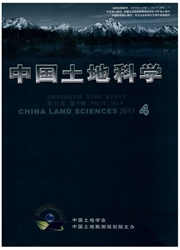

 中文摘要:
中文摘要:
研究目的:从人口城镇化和土地城镇化两个角度探讨二者协调发展的时间演变规律以及空间差异。研究方法:采用重心转移模型以及人口城镇与土地城镇化协调性指数的方法。研究结果:(1)浙江省69县市的城镇人口增长率分布在0-46.37%之间;而城市建成区面积增长率分布在0-149.70%,从数量上比较,部分城市二者出现失调现象;(2)通过重心转移模型发现,2005-2010年人口重心向西南方向转移了1891.04 m,建成区扩展的重心由南向北转移5029.73 m,二者重心转移的方向有所差异;(3)41个县市的协调性指数都达到了0.9以上,说明这些地区的人口城镇化和土地城镇化的发展协调;10个县市的协调性指数在0.8-0.9之间,属于基本协调。研究结论:浙江省的城镇化总体水平较高,但是不同县市中,人口城镇化和土地城镇化的协调发展程度有所差异,所以在失调县市,需要进一步加强土地的集约利用,挖掘土地利用潜力,提高土地利用效率。
 英文摘要:
英文摘要:
This paper attempts to explore the both evolution patterns and spatial differences between population urbanization and land urbanization. Shifting model and coordinate index of population urbanization and land urbanization are used as research methods. Research results are as follow. Firstly, the urban population growth rates of 69 counties in Zhejiang Province range from 0 to 46.37%, while urban built-up area growth rates range from 0%to 149.70%. There is imbalance in some cities from the quantitative angle. Secondly, it can be known that the population focus has been 1891.04 m southwestwards away and the built-up extension focus has been 5029.73 m northwards away between 2005 and 2010 from shifting model. It shows the different directions of population urbanization and land urbanization. Thirdly, coordinate development index of 41 counties are above 0.9, which means population urbanization and land urbanization of these areas are highly coordinate. And there are 10 other counties are believed to be developing coordinately since the index values are bigger than 0.8 but smaller than 0.9. Therefore, it can be concluded that the overall urbanization level of the whole Zhejiang Province is high though few counties are low in land use efficiency, which should be improved in the future.
 同期刊论文项目
同期刊论文项目
 同项目期刊论文
同项目期刊论文
 期刊信息
期刊信息
